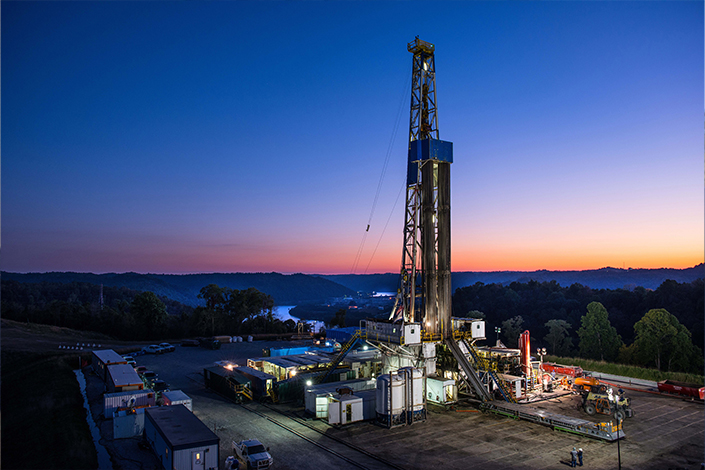West Virginia’s Energy Influence
By Megan Bevins

As one of the nation’s leading energy exporters, West Virginia is using its abundant resources to position itself as a dominant force in the energy sector. While the Mountain State has already made a name for itself on a national scale in terms of coal production, new projects are underway to further expand its reach.
Nick Preservati, deputy secretary for the West Virginia Department of Commerce, explains that with the state’s proximity to northeastern markets, it is a crucial supplier of natural gas, particularly during the winter when there is a risk of freezing temperatures and power outages. Preservati says natural gas storage fields are strategically located to meet this demand, and infrastructure is continually expanding.
“New pipeline projects have been developed to transport natural gas from West Virginia’s Marcellus and Utica Shale regions to markets in the Midwest,” Preservati says. “These pipelines enhance the delivery of natural gas to power plants in states like Ohio, Pennsylvania and beyond.”
Charlie Burd, president of the Gas & Oil Association of West Virginia (GO-WV), mentions examples like the Morgantown Connector Project, operated by Hope Gas, which will run from Wadestown to Morgantown and then to Osage. He also describes an intrastate pipeline that is being developed to transport natural gas from the Tyler County area to Willow Island, where a former coal plant will use both coal and natural gas to produce hydrogen.
Burd says that West Virginia remains the fourth largest producer of natural gas in the country, with more than 3.2 trillion cubic feet of production in 2023. Overall, the state provides almost 8% of total natural gas production in the U.S.
“West Virginia’s residential, commercial and industrial customers use but a fraction of total natural gas produced in state,” Burd says. “Nearly all production is shipped by pipeline out of West Virginia to key markets in the northeast and eastern seaboard including cities like Boston, New York City, Washington, D.C. and countless others in the near south and west.”
Burd explains that the state’s competitive advantage against states with large natural gas resources like Texas, Louisiana, Pennsylvania and New Mexico is its proximity to large East Coast industrial and electric power generation markets.
“Natural gas produced in West Virginia is some of the cleanest produced energy in the world,” Burd says. “The use of West Virginia-produced natural gas directly contributes to the reduction in greenhouse emission sought by companies, communities and our country. Natural gas produced in the state directly contributes to global energy dominance. Energy dominance is energy security for our nation.”
Beyond pipeline development, West Virginia strengthens its role in the national energy grid by fostering partnerships that help further expand resources across state lines. One example is the expansion of the Mountain Valley Pipeline, which connected the state’s natural gas resources to markets in the Southeast. The state also works closely with regional transmission organizations to help ensure grid stability and energy security in these broader areas.
“These partnerships not only improve the reliability and efficiency of energy delivery but also provide economic benefits and keep energy prices competitive for families across the region,” Preservati says.
While many states are reducing or stopping coal production due to stricter rules and regulations, West Virginia is stepping in to meet the growing energy demand.
Chris Hamilton, president of the West Virginia Coal Association, says West Virginia coal supplies 31 power plants across 15 states and fuels 56 steelmaking facilities in 20 states. It supports more than 70% of domestic steel production, sustaining over 547,000 jobs nationwide.
“Globally, West Virginia is the leading coal export state, accounting for nearly 58% of all the coal that leaves our nation’s ports for the export market,” Hamilton says. “In totality, West Virginia exports as much coal as it consumes domestically.”
Preservati adds that although federal laws often shift with changing administrations, there are currently legislative acts within the state to help grow coal and natural gas production and distribution in West Virginia, positioning the state for even greater energy exports in the future.
A key factor in keeping West Virginia at the forefront of national energy is infrastructure investment. Preservati explains that this could mean upgrading the state’s power plants, expanding natural gas pipelines, improving transmission lines and investing in clean coal technologies.
“Strengthening these key areas while fostering partnerships with private companies will create good-paying jobs, lower energy costs for families and solidify West Virginia’s place as a critical player in the national energy grid,” Preservati says.
Ben Beakes, president of Metallurgical Coal Producers Association, says supplying metallurgical coal to steel production—which is a vital source of heat—is essential to West Virginia’s energy sector, and these advancements in infrastructure drive the demand for metallurgical coal.
“Expanding infrastructure—whether roads, buildings or gas pipelines—relies heavily on steel and, consequently, on met coal, underscoring the critical link between infrastructure development and the met coal industry,” Beakes says.
Metallurgical coal accounts for 75% of global coal exports, with West Virginia leading the nation in its output. Within the state, metallurgical coal represents 30-40% of total coal production.
Beakes says multiple states work together to ensure this metallurgical coal is transported efficiently.
“Approximately two-thirds of all met coal exported from the U.S. is shipped through ports near Norfolk, VA, with most West Virginia met coal traveling through Norfolk or the ports in Baltimore, MD,” he says. “Additionally, most metallurgical coal companies operate multiple mines across the central Appalachian region, encompassing Kentucky, Virginia and West Virginia, each contributing unique coal properties necessary for the blending process to meet specific customer requirements.”
Looking ahead, the Mountain State plans to implement data centers to further secure its spot as an energy powerhouse. These facilities, designed to house computer systems and other technological infrastructure, could be located in the state’s abandoned mines.
Hamilton says West Virginia is looking at building as many new data centers as possible under the current electrical manufacturing ecosystem.
“What this will do is not only use more coal-fueled electricity, but it will also help that plant run at a higher level and hopefully reduce cost for all end users or consumers,” Hamilton says.
With the numerous former mine sites offering ample space and proximity to the energy grid, West Virginia is well positioned to support the expansion of data centers. Locations along the Ohio River would also be strategically positioned to facilitate power exports into Virginia.
Burd adds that natural gas-powered merchant plants will generate electricity for the open market, meeting the growing demand from major data centers across the northeast, east and south, which could also help attract new development to West Virginia.
As these initiatives progress, West Virginia’s commitment to innovation will continue to strengthen its position in the national energy landscape.








